Temporal Dynamics and Source Apportionment of PM2.5 in a Coastal City of Southeastern China: Insights from Multiyear Analysis
Abstract
1. Introduction
2. Materials and Methods
2.1. Sample Collection and Chemical Analysis
2.2. PMF Model
2.3. Backward Trajectory Simulations: Cluster Analysis and PSCF Analysis
3. Results and Discussions
3.1. Chemical Compositions of Ambient PM2.5
3.2. Source Apportionment of PM2.5
3.2.1. PMF Model Setup and Validation
3.2.2. Source Profiles and Contributions
Factor 1: Fugitive Dust
Factor 2: Ship Emissions
Factor 3: SOA and Industrial Emissions
Factor 4: Secondary Sulfate
Factor 5: Coal Combustion and Vehicle Emissions
3.3. Backward Trajectory Cluster and PSCF Analysis
3.3.1. Backward Trajectory Clustering
3.3.2. PSCF Analysis
- Pearl River Delta, a major industrial and urban agglomeration in southern China.
- Areas spanning northern Fujian to the Yangtze River Delta, indicating contributions from industrial and urban emissions in these regions.
- The maritime area between Shanghai and Jeju Island, suggesting the influence of ship emissions and transboundary transport.
4. Conclusions
Supplementary Materials
Author Contributions
Funding
Institutional Review Board Statement
Informed Consent Statement
Data Availability Statement
Conflicts of Interest
References
- Zhu, T.; Liu, Y.; Xu, S.; Dong, G.; Huang, C.; Sang, N.; Zhang, Y.; Su, G.; Chen, J.; Gong, J.; et al. Advances and perspectives in environmental health research in China. Front. Environ. Sci. Eng. 2024, 18, 76. [Google Scholar] [CrossRef]
- Darrow, L.A.; Klein, M.; Flanders, W.D.; Mulholland, J.A.; Tolbert, P.E.; Strickland, M.J. Air pollution and acute respiratory infections among children 0–4 years of age: An 18-year time-series study. Am. J. Epidemiol. 2014, 180, 968–977. [Google Scholar] [CrossRef] [PubMed]
- Huang, C.; Nichols, C.; Liu, Y.; Zhang, Y.; Liu, X.; Gao, S.; Li, Z.; Ren, A. Ambient air pollution and adverse birth outcomes: A natural experiment study. Popul. Health Metr. 2015, 13, 17. [Google Scholar] [CrossRef] [PubMed]
- Schraufnagel, D.E.; Balmes, J.R.; Cowl, C.T.; De Matteis, S.; Jung, S.-H.; Mortimer, K.; Perez-Padilla, R.; Rice, M.B.; Riojas-Rodriguez, H.; Sood, A.; et al. Air Pollution and Noncommunicable Diseases: A Review by the Forum of International Respiratory Societies’ Environmental Committee, Part 2: Air Pollution and Organ Systems. Chest 2019, 155, 417–426. [Google Scholar] [CrossRef]
- Intergovernmental Panel on Climate Change. Working Group I Contribution to the Fifth Assessment Report of the Intergovernmental Panel on Climate Change. In Climate Change 2013—The Physical Science Basis; Cambridge University Press: Cambridge, MA, USA, 2014. [Google Scholar]
- Zhou, H.; Yue, X.; Dai, H.; Geng, G.; Yuan, W.; Chen, J.; Shen, G.; Zhang, T.; Zhu, J.; Liao, H. Recovery of ecosystem productivity in China due to the Clean Air Action plan. Nat. Geosci. 2024, 17, 1233–1239. [Google Scholar] [CrossRef]
- Matson, P.; Kathleen, A.L.; Hall, S.J. The Globalization of Nitrogen Deposition: Consequences for Terrestrial Ecosystems. Ambio 2002, 31, 113–119. [Google Scholar] [CrossRef] [PubMed]
- Liu, B.; Wu, J.; Zhang, J.; Wang, L.; Yang, J.; Liang, D.; Dai, Q.; Bi, X.; Feng, Y.; Zhang, Y.; et al. Characterization and source apportionment of PM2.5 based on error estimation from EPA PMF 5.0 model at a medium city in China. Environ. Pollut. 2017, 222, 10–22. [Google Scholar] [CrossRef]
- Zhang, N.; Zhuang, M.; Tian, J.; Tian, P.; Zhang, J.; Wang, Q.; Zhou, Y.; Huang, R.; Zhu, C.; Zhang, X.; et al. Development of source profiles and their application in source apportionment of PM2.5 in Xiamen, China. Front. Environ. Sci. Eng. 2016, 10, 17. [Google Scholar] [CrossRef]
- Zhang, Q.; Meng, X.; Shi, S.; Kan, L.; Chen, R.; Kan, H. Overview of particulate air pollution and human health in China: Evidence, challenges, and opportunities. Innovation 2022, 3, 100312. [Google Scholar] [CrossRef]
- Huang, R.J.; Zhang, Y.; Bozzetti, C.; Ho, K.F.; Cao, J.J.; Han, Y.; Daellenbach, K.R.; Slowik, J.G.; Platt, S.M.; Canonaco, F.; et al. High secondary aerosol contribution to particulate pollution during haze events in China. Nature 2014, 514, 218–222. [Google Scholar] [CrossRef]
- Dai, X.; Zhang, Z.; Jin, Y.; Niu, Y.; Cao, H.; Liang, X.; Chen, L.; Wang, J.; Peng, X. Solution-processed, high-performance light-emitting diodes based on quantum dots. Nature 2014, 515, 96–99. [Google Scholar] [CrossRef]
- Gu, J.; Bai, Z.; Li, W.; Wu, L.; Liu, A.; Dong, H.; Xie, Y. Chemical composition of PM2.5 during winter in Tianjin, China. Particuology 2011, 9, 215–221. [Google Scholar] [CrossRef]
- Kang, H.; Zhu, B.; Su, J.; Wang, H.; Zhang, Q.; Wang, F. Analysis of a long-lasting haze episode in Nanjing, China. Atmos. Res. 2013, 120–121, 78–87. [Google Scholar] [CrossRef]
- Cheng, J.; Su, J.; Cui, T.; Li, X.; Dong, X.; Sun, F.; Yang, Y.; Tong, D.; Zheng, Y.; Li, Y.; et al. Dominant role of emission reduction in PM2.5 air quality improvement in Beijing during 2013–2017: A model-based decomposition analysis. Atmos. Chem. Phys. 2019, 19, 6125–6146. [Google Scholar] [CrossRef]
- Zhao, B.; Wang, S.X.; Hao, J.M. Challenges and perspectives of air pollution control in China. Front. Environ. Sci. Eng. 2024, 18, 68. [Google Scholar] [CrossRef]
- Ting, F.; Chen, T.; Li, M.; Chi, J.; Tang, H.; Zhang, T.; Li, H. Discrimination of the pollution grade of metal elements in atmospherically deposited particulate matter via laser-induced breakdown spectroscopy combined with machine learning method. Chemom. Intell. Lab. Syst. 2022, 231, 104691. [Google Scholar] [CrossRef]
- Zhu, Y.; Huang, L.; Li, J.; Ying, Q.; Zhang, H.; Liu, X.; Liao, H.; Li, N.; Liu, Z.; Mao, Y. Sources of particulate matter in China: Insights from source apportionment studies published in 1987–2017. Environ. Int. 2018, 115, 343–357. [Google Scholar] [CrossRef] [PubMed]
- Pai, S.J.; Carter, T.S.; Heald, C.L.; Kroll, J.H. Updated World Health Organization Air Quality Guidelines Highlight the Importance of Non-anthropogenic PM2.5. Environ. Sci. Technol. Lett. 2022, 9, 501–506. [Google Scholar] [CrossRef]
- Wang, S.; Hu, G.; Yan, Y.; Wang, S.; Yu, R.; Cui, J. Source apportionment of metal elements in PM2.5 in a coastal city in Southeast China: Combined Pb-Sr-Nd isotopes with PMF method. Atmos. Environ. 2019, 198, 302–312. [Google Scholar] [CrossRef]
- Wu, S.-P.; Cai, M.-J.; Xu, C.; Zhang, N.; Zhou, J.-B.; Yan, J.-P.; Schwab, J.J.; Yuan, C.-S. Chemical nature of PM2.5 and PM10 in the coastal urban Xiamen, China: Insights into the impacts of shipping emissions and health risk. Atmos. Environ. 2020, 227, 117383. [Google Scholar] [CrossRef]
- Wu, S.-P.; Xu, C.; Dai, L.-H.; Zhang, N.; Wei, Y.; Gao, Y.; Yan, J.-P.; Schwab, J.J. Source Apportionment of PM2.5 at Urban and Suburban Sites in a Port City of Southeastern China. Aerosol Air Qual. Res. 2019, 19, 2017–2031. [Google Scholar] [CrossRef]
- Taghvaee, S.; Sowlat, M.H.; Mousavi, A.; Hassanvand, M.S.; Yunesian, M.; Naddafi, K.; Sioutas, C. Source apportionment of ambient PM2.5 in two locations in central Tehran using the Positive Matrix Factorization (PMF) model. Sci. Total Environ. 2018, 628–629, 672–686. [Google Scholar] [CrossRef]
- Paatero, P.; Tapper, U. Positive matrix factorization: A non-negative factor model with optimal utilization of error estimates of data values. Environmetrics 1994, 5, 111–126. [Google Scholar] [CrossRef]
- Paatero, P. End User’s Guide to Multilinear Engine Applications; University of Helsinki: Helsinki, Finland, 2007. [Google Scholar]
- Brown, S.G.; Eberly, S.; Paatero, P.; Norris, G.A. Methods for estimating uncertainty in PMF solutions: Examples with ambient air and water quality data and guidance on reporting PMF results. Sci. Total Environ. 2015, 518–519, 626–635. [Google Scholar] [CrossRef]
- Seibert, P.; Frank, A. Source-receptor matrix calculation with a Lagrangian particle dispersion model in backward mode. Atmos. Chem. Phys. 2004, 4, 51–63. [Google Scholar] [CrossRef]
- Wang, Y.Q.; Zhang, X.Y.; Draxler, R.R. TrajStat: GIS-based software that uses various trajectory statistical analysis methods to identify potential sources from long-term air pollution measurement data. Environ. Model. Softw. 2009, 24, 938–939. [Google Scholar] [CrossRef]
- Wang, Y. An Open Source Software Suite for Multi-Dimensional Meteorological Data Computation and Visualisation. J. Open Res. Softw. 2019, 7, 21. [Google Scholar] [CrossRef]
- Xu, L.; Chen, J.; Yang, L.; Niu, Z.; Tong, L.; Yin, L.; Chen, Y. Characteristics and sources of atmospheric mercury speciation in a coastal city, Xiamen, China. Chemosphere 2015, 119, 530–539. [Google Scholar] [CrossRef] [PubMed]
- Markou, M.T.; Kassomenos, P. Cluster analysis of five years of back trajectories arriving in Athens, Greece. Atmos. Res. 2010, 98, 438–457. [Google Scholar] [CrossRef]
- Zeng, Y.; Hopke, P.K. A study of the sources of acid precipitation in Ontario, Canada. Atmos. Environ. (1967) 1989, 23, 1499–1509. [Google Scholar] [CrossRef]
- Polissar, A.V.; Hopke, P.K.; Harris, J.M. Source regions for atmospheric aerosol measured at Barrow, Alaska. Environ. Sci. Technol. 2001, 35, 4214–4226. [Google Scholar] [CrossRef]
- GB 3095-2012; Ambient Air Quality Standards. Ministry of Environmental Protection of the People’s Republic of China: Beijing, China, 2012.
- Wang, S.; Yan, Y.; Yu, R.; Shen, H.; Hu, G.; Wang, S. Influence of pollution reduction interventions on atmospheric PM2.5: A case study from the 2017 Xiamen. Atmos. Pollut. Res. 2021, 12, 101137. [Google Scholar] [CrossRef]
- Lee, J.H.; Hopke, P.K.; Holsen, T.M.; Polissar, A.V. Evaluation of continuous and filter-based methods for measuring PM2.5 mass concentration. Aerosol Sci. Technol. 2005, 39, 290–303. [Google Scholar] [CrossRef]
- Xu, H.; Guinot, B.; Shen, Z.; Ho, K.; Niu, X.; Xiao, S.; Huang, R.-J.; Cao, J. Characteristics of Organic and Elemental Carbon in PM2.5 and PM0.25 in Indoor and Outdoor Environments of a Middle School: Secondary Formation of Organic Carbon and Sources Identification. Atmosphere 2015, 6, 361–379. [Google Scholar] [CrossRef]
- Azarmi, F.; Kumar, P.; Marsh, D.; Fuller, G. Assessment of the long-term impacts of PM10 and PM2.5 particles from construction works on surrounding areas. Environ. Sci. Process. Impacts 2016, 18, 208–221. [Google Scholar] [CrossRef] [PubMed]
- Chaturvedi, S.; Kumar, A.; Singh, V.; Chakraborty, B.; Kumar, R.; Min, L. Recent Advancement in Organic Aerosol Understanding: A Review of Their Sources, Formation, and Health Impacts. Water Air Soil Pollut. 2023, 234, 750. [Google Scholar] [CrossRef]
- Feng, J.; Chan, C.K.; Fang, M.; Hu, M.; He, L.; Tang, X. Impact of meteorology and energy structure on solvent extractable organic compounds of PM2.5 in Beijing, China. Chemosphere 2005, 61, 623–632. [Google Scholar] [CrossRef]
- Tian, Y.; Liu, X.; Huo, R.; Shi, Z.; Sun, Y.; Feng, Y.; Harrison, R.M. Organic compound source profiles of PM2.5 from traffic emissions, coal combustion, industrial processes and dust. Chemosphere 2021, 278, 130429. [Google Scholar] [CrossRef]
- GB18352.3-2005; Limits and Measurement Methods for Emissions from Light-Duty Vehicles (III, IV). Ministry of Environmental Protection of the People’s Republic of China: Beijing, China, 2005.
- Liu, B.; Song, N.; Dai, Q.; Mei, R.; Sui, B.; Bi, X.; Feng, Y. Chemical composition and source apportionment of ambient PM2.5 during the non-heating period in Taian, China. Atmos. Res. 2016, 170, 23–33. [Google Scholar] [CrossRef]
- Manousakas, M.; Papaefthymiou, H.; Diapouli, E.; Migliori, A.; Karydas, A.G.; Bogdanovic-Radovic, I.; Eleftheriadis, K. Assessment of PM2.5 sources and their corresponding level of uncertainty in a coastal urban area using EPA PMF 5.0 enhanced diagnostics. Sci. Total Environ. 2017, 574, 155–164. [Google Scholar] [CrossRef]
- Xue, Y.-H.; Wu, J.-H.; Feng, Y.-C.; Dai, L.; Bi, X.-H.; Li, X.; Zhu, T.; Tang, S.-B.; Chen, M.-F. Source Characterization and Apportionment of PM10 in Panzhihua, China. Aerosol Air Qual. Res. 2010, 10, 367–377. [Google Scholar] [CrossRef]
- Peltier, R.E.; Cromar, K.R.; Ma, Y.; Fan, Z.-H.; Lippmann, M. Spatial and seasonal distribution of aerosol chemical components in New York City: (2) Road dust and other tracers of traffic-generated air pollution. J. Expo. Sci. Environ. Epidemiol. 2011, 21, 484–494. [Google Scholar] [CrossRef] [PubMed]
- Pant, P.; Harrison, R.M. Estimation of the contribution of road traffic emissions to particulate matter concentrations from field measurements: A review. Atmos. Environ. 2013, 77, 78–97. [Google Scholar] [CrossRef]
- Huang, G.; Wang, H.; Xu, D. Understanding the complementary effect of bike-sharing on public transit: A case study of subway line expansion in Xiamen, China. J. Transp. Geogr. 2024, 121, 104021. [Google Scholar] [CrossRef]
- Tian, L.; Yao, Z.; Fan, C.; Zhou, L. A systems approach to enabling affordable housing for migrants through upgrading Chengzhongcun: A case of Xiamen. Cities 2020, 105, 102186. [Google Scholar] [CrossRef]
- Lang, J.; Zhou, Y.; Chen, D.; Xing, X.; Wei, L.; Wang, X.; Zhao, N.; Zhang, Y.; Guo, X.; Han, L.; et al. Investigating the contribution of shipping emissions to atmospheric PM2.5 using a combined source apportionment approach. Environ. Pollut. 2017, 229, 557–566. [Google Scholar] [CrossRef]
- Cesari, R.; Genga, A.; Buccolieri, R.; Di Sabatino, S.; Siciliano, M.; Siciliano, T.; Dinoi, A.; Maurizi, A.; Ielpo, P. Combining Chemical Composition Data and Numerical Modelling for the Assessment of Air Quality in a Mediterranean Port City. Appl. Sci. 2021, 11, 2181. [Google Scholar] [CrossRef]
- Jeong, J.-H.; Shon, Z.-H.; Kang, M.; Song, S.-K.; Kim, Y.-K.; Park, J.; Kim, H. Comparison of source apportionment of PM2.5 using receptor models in the main hub port city of East Asia: Busan. Atmos. Environ. 2017, 148, 115–127. [Google Scholar] [CrossRef]
- Tao, J.; Zhang, L.; Cao, J.; Zhong, L.; Chen, D.; Yang, Y.; Chen, D.; Chen, L.; Zhang, Z.; Wu, Y.; et al. Source apportionment of PM2.5 at urban and suburban areas of the Pearl River Delta region, south China—With emphasis on ship emissions. Sci. Total Environ. 2017, 574, 1559–1570. [Google Scholar] [CrossRef]
- Yau, P.S.; Lee, S.C.; Cheng, Y.; Huang, Y.; Lai, S.C.; Xu, X.H. Contribution of ship emissions to the fine particulate in the community near an international port in Hong Kong. Atmos. Res. 2013, 124, 61–72. [Google Scholar] [CrossRef]
- Kim, E.; Hopke, P.K. Source characterization of ambient fine particles at multiple sites in the Seattle area. Atmos. Environ. 2008, 42, 6047–6056. [Google Scholar] [CrossRef]
- Agrawal, H.; Eden, R.; Zhang, X.; Fine, P.M.; Katzenstein, A.; Miller, J.W.; Ospital, J.; Teffera, S.; Cocker, D.R., III. Primary Particulate Matter from Ocean-Going Engines in the Southern California Air Basin. Environ. Sci. Technol. 2009, 43, 5398–5402. [Google Scholar] [CrossRef]
- Saraga, D.E.; Tolis, E.I.; Maggos, T.; Vasilakos, C.; Bartzis, J.G. PM2.5 source apportionment for the port city of Thessaloniki, Greece. Sci. Total Environ. 2019, 650, 2337–2354. [Google Scholar] [CrossRef]
- Zhang, F.; Zhao, J.; Chen, J.; Xu, Y.; Xu, L. Pollution characteristics of organic and elemental carbon in PM2.5 in Xiamen, China. J. Environ. Sci. (China) 2011, 23, 1342–1349. [Google Scholar] [CrossRef]
- Gu, J.; Bai, Z.; Liu, A.; Wu, L.; Xie, Y.; Li, W.; Dong, H.; Zhang, X. Characterization of Atmospheric Organic Carbon and Element Carbon of PM2.5 and PM10 at Tianjin, China. Aerosol Air Qual. Res. 2010, 10, 167–176. [Google Scholar] [CrossRef]
- Reichert, L.; Andrés Hernández, M.D.; Stöbener, D.; Burkert, J.; Burrows, J.P. Investigation of the effect of water complexes in the determination of peroxy radical ambient concentrations: Implications for the atmosphere. J. Geophys. Res. Atmos. 2003, 108, ACH 4-1–ACH 4-16. [Google Scholar] [CrossRef]
- Wang, Y.; Luo, H.; Jia, L.; Ge, S. Effect of particle water on ozone and secondary organic aerosol formation from benzene-NO2-NaCl irradiations. Atmos. Environ. 2016, 140, 386–394. [Google Scholar] [CrossRef]
- Liang, L.; Engling, G.; Cheng, Y.; Zhang, X.; Sun, J.; Xu, W.; Liu, C.; Zhang, G.; Xu, H.; Liu, X.; et al. Influence of High Relative Humidity on Secondary Organic Carbon: Observations at a Background Site in East China. J. Meteorol. Res. 2019, 33, 905–913. [Google Scholar] [CrossRef]
- Eatough, D.J.; Caka, F.M.; Farber, R.J. The Conversion of SO2 to Sulfate in the Atmosphere. Isr. J. Chem. 1994, 34, 301–314. [Google Scholar] [CrossRef]
- Flamm, D.L.; Bacon, D.D.; Kinsbron, E.; English, A.T. Chemical Reaction of Sulfur Dioxide at High Humidity and Temperature: Implications for Accelerated Testing. J. Electrochem. Soc. 1981, 128, 679. [Google Scholar] [CrossRef]
- Bhangare, R.C.; Ajmal, P.Y.; Sahu, S.K.; Pandit, G.G.; Puranik, V.D. Distribution of trace elements in coal and combustion residues from five thermal power plants in India. Int. J. Coal Geol. 2011, 86, 349–356. [Google Scholar] [CrossRef]
- Che, K.; Chen, C.-M.; Zheng, Q.-Y.; Fan, H.; Wei, M.-L.; Luo, P.; Yu, J.-X. Heavy Metal Rmissions from Coal-fired Power Plants and Heavy Metal Pollution Characteristics and Health Risks in Surrounding Soils. Environ. Sci. 2022, 43, 4578–4589. [Google Scholar]
- Harrison, R.M.; Jones, A.M.; Gietl, J.; Yin, J.; Green, D.C. Estimation of the Contributions of Brake Dust, Tire Wear, and Resuspension to Nonexhaust Traffic Particles Derived from Atmospheric Measurements. Environ. Sci. Technol. 2012, 46, 6523–6529. [Google Scholar] [CrossRef]
- Lin, Y.C.; Tsai, C.J.; Wu, Y.C.; Zhang, R.; Chi, K.H.; Huang, Y.T.; Lin, S.H.; Hsu, S.C. Characteristics of trace metals in traffic-derived particles in Hsuehshan Tunnel, Taiwan: Size distribution, potential source, and fingerprinting metal ratio. Atmos. Chem. Phys. 2015, 15, 4117–4130. [Google Scholar] [CrossRef]
- Duong, T.T.T.; Lee, B.-K. Determining contamination level of heavy metals in road dust from busy traffic areas with different characteristics. J. Environ. Manag. 2011, 92, 554–562. [Google Scholar] [CrossRef]
- Yao, L.; Yang, L.; Yuan, Q.; Yan, C.; Dong, C.; Meng, C.; Sui, X.; Yang, F.; Lu, Y.; Wang, W. Sources apportionment of PM2.5 in a background site in the North China Plain. Sci. Total Environ. 2016, 541, 590–598. [Google Scholar] [CrossRef]
- Li, Y.; Cui, S.; Gao, B.; Tang, J.; Huang, W.; Huang, Y. Modeling nitrogen flow in a coastal city—A case study of Xiamen in 2015. Sci. Total Environ. 2020, 735, 139294. [Google Scholar] [CrossRef]
- Yuan, M.; Song, Y.; Hong, S.; Huang, Y. Evaluating the effects of compact growth on air quality in already-high-density cities with an integrated land use-transport-emission model: A case study of Xiamen, China. Habitat Int. 2017, 69, 37–47. [Google Scholar] [CrossRef]
- OECD. Ocean Shipping and Shipbuilding; The Organisation for Economic Co-operation and Development: Paris, France, 2021. [Google Scholar]

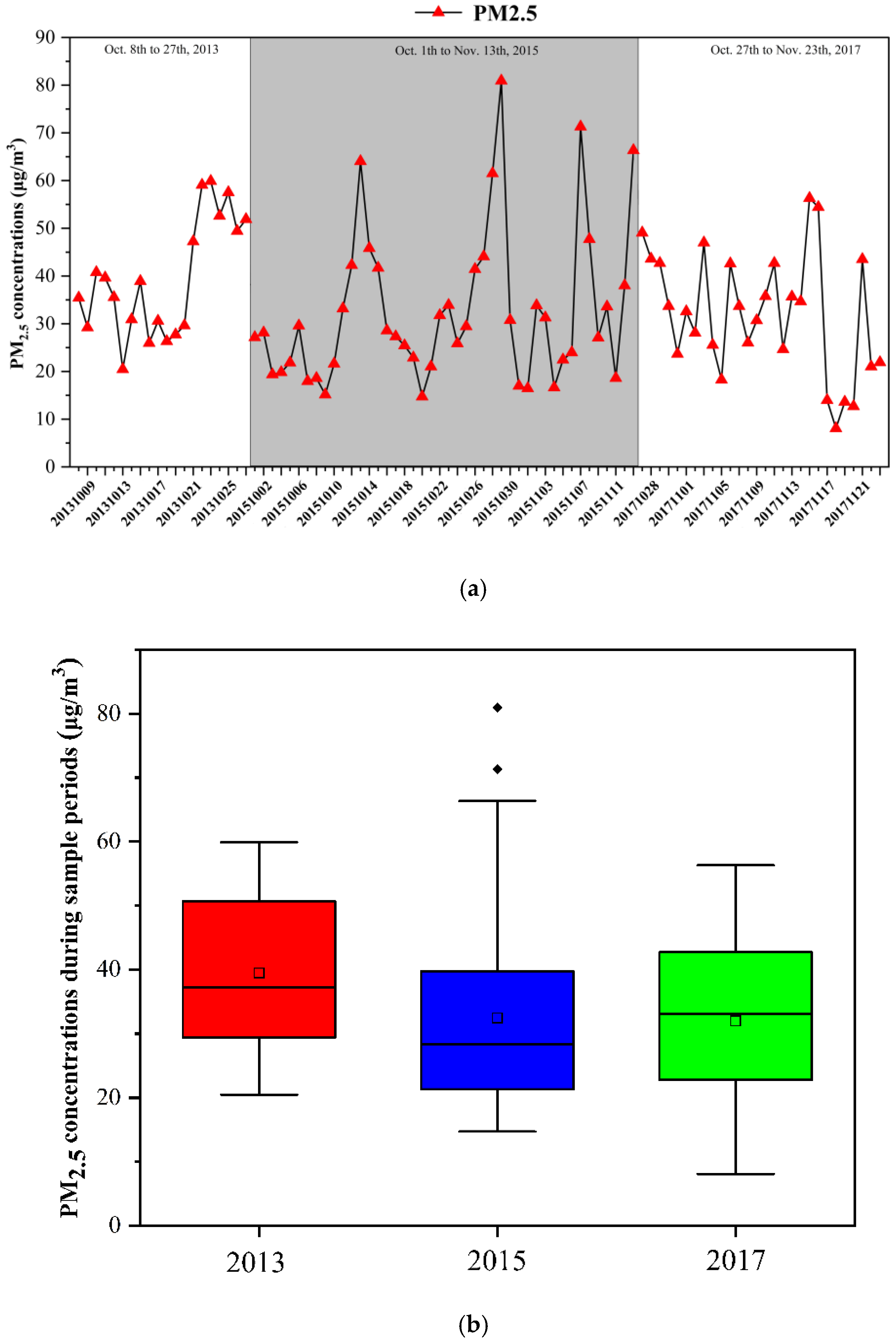
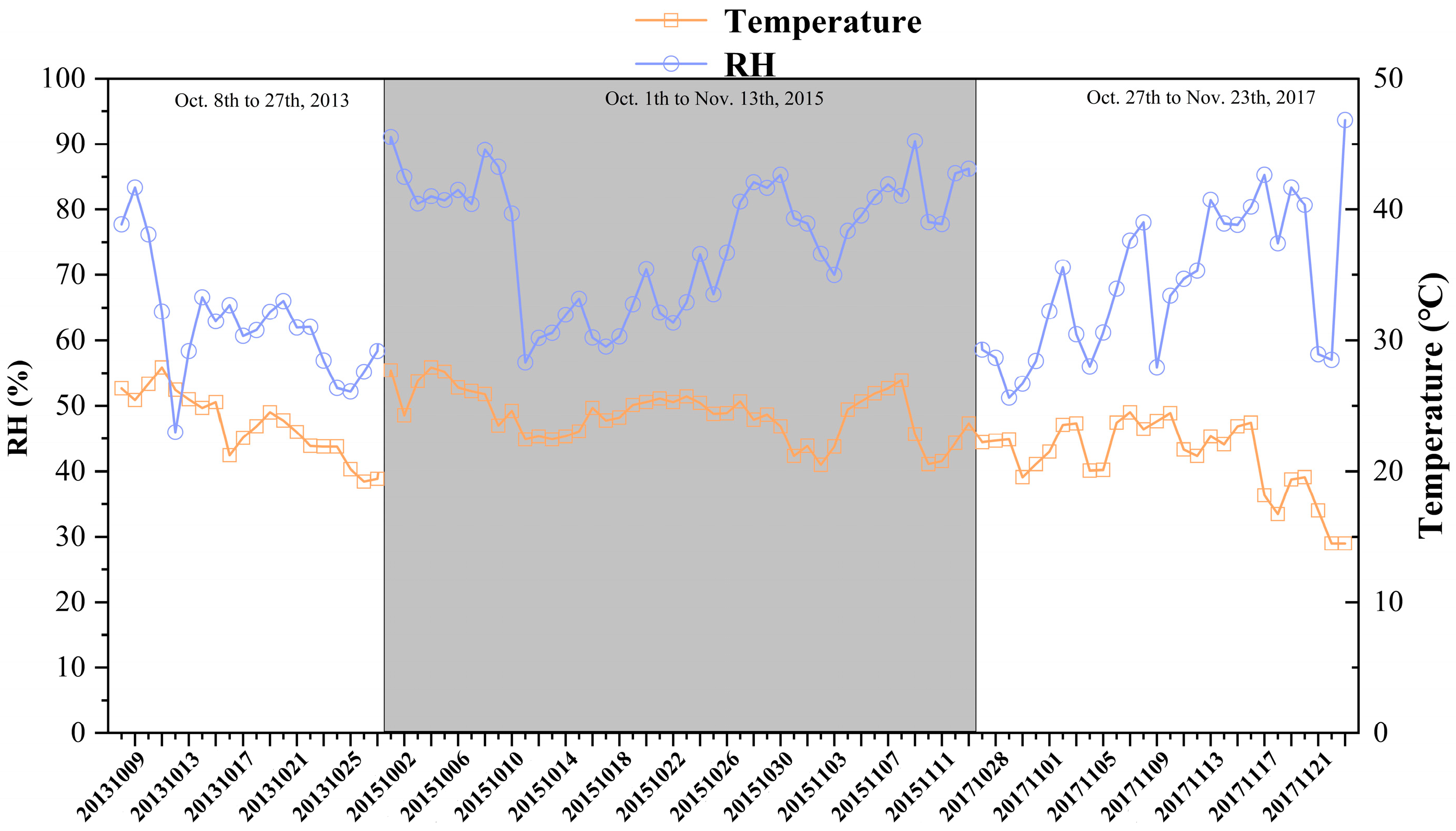


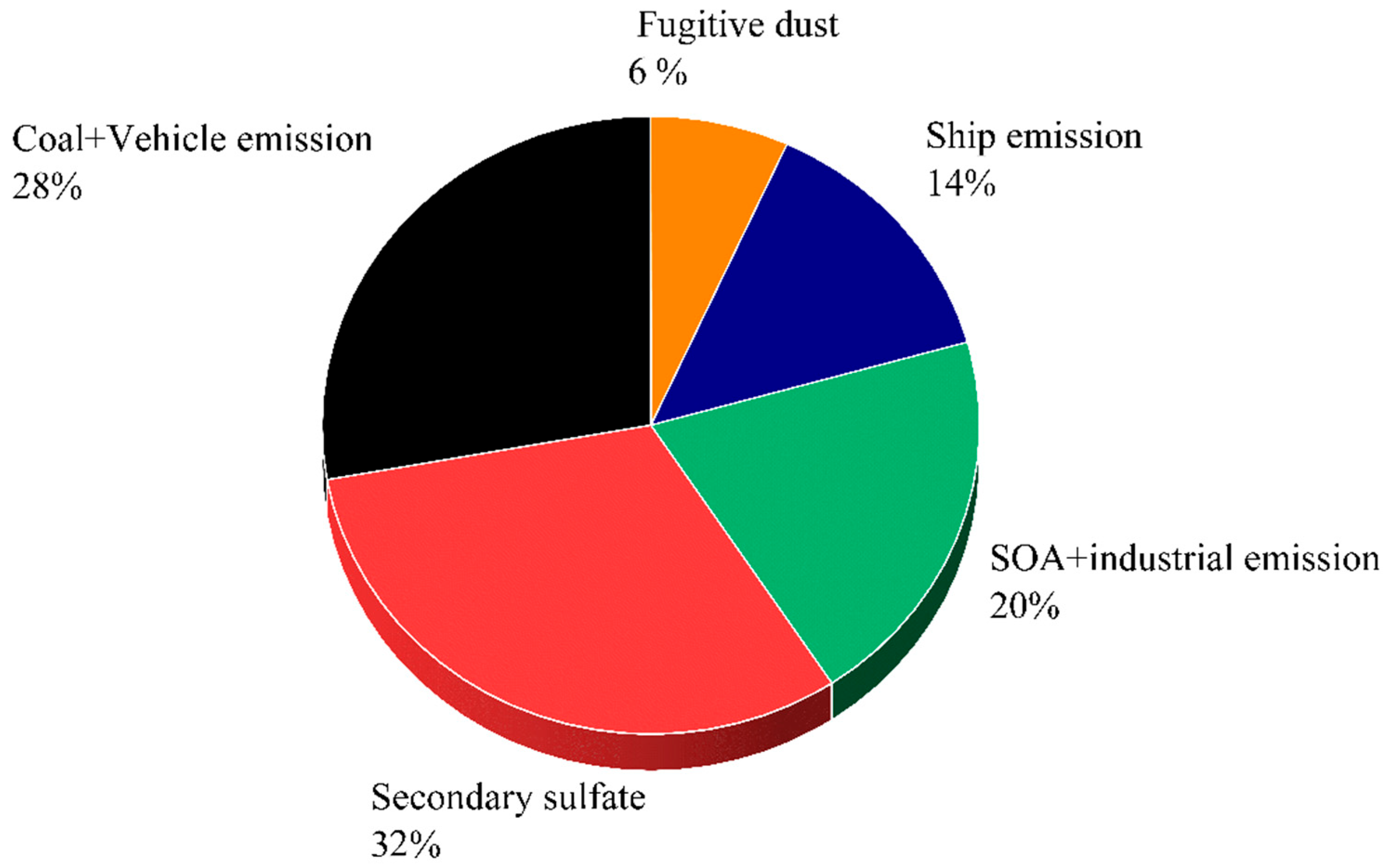
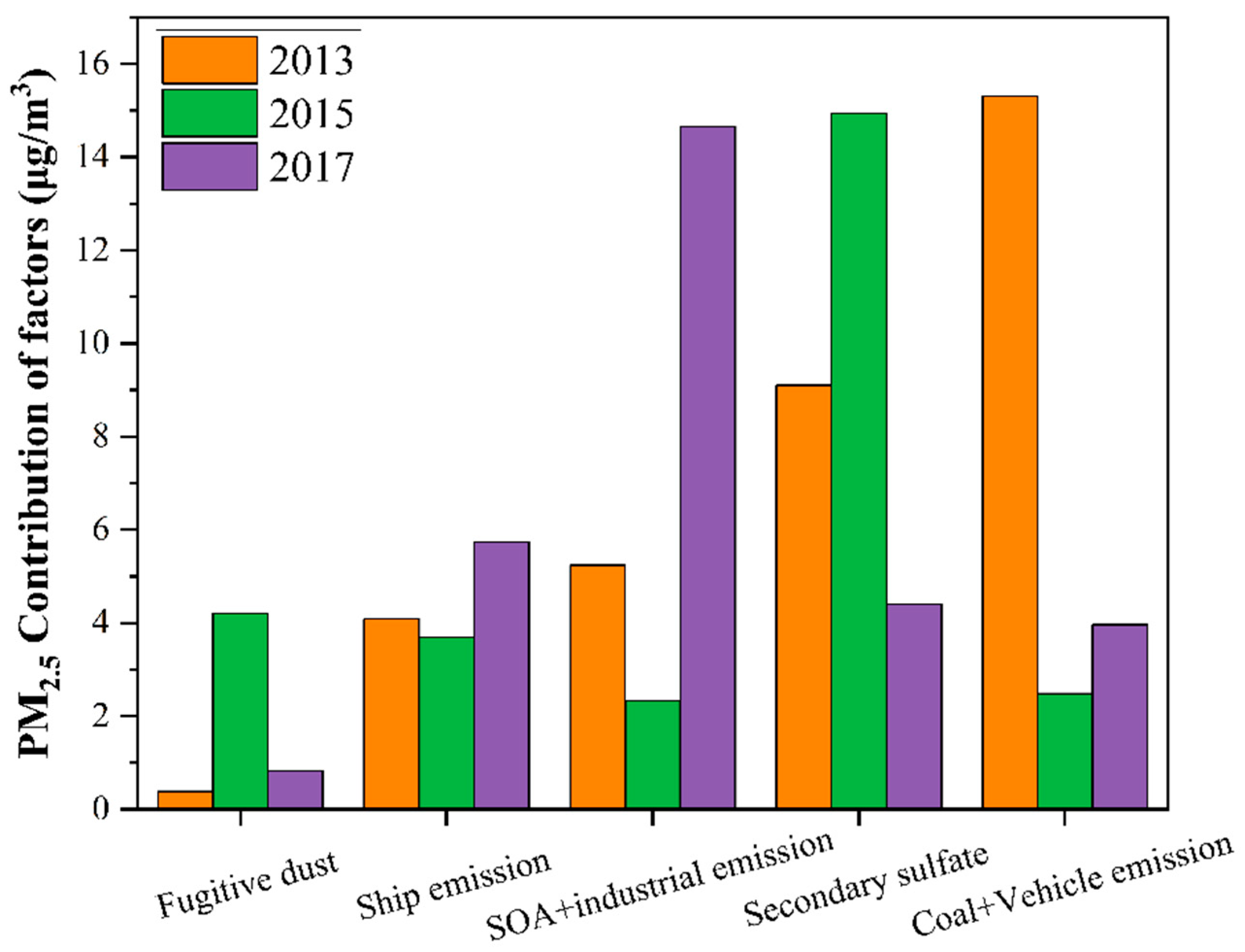
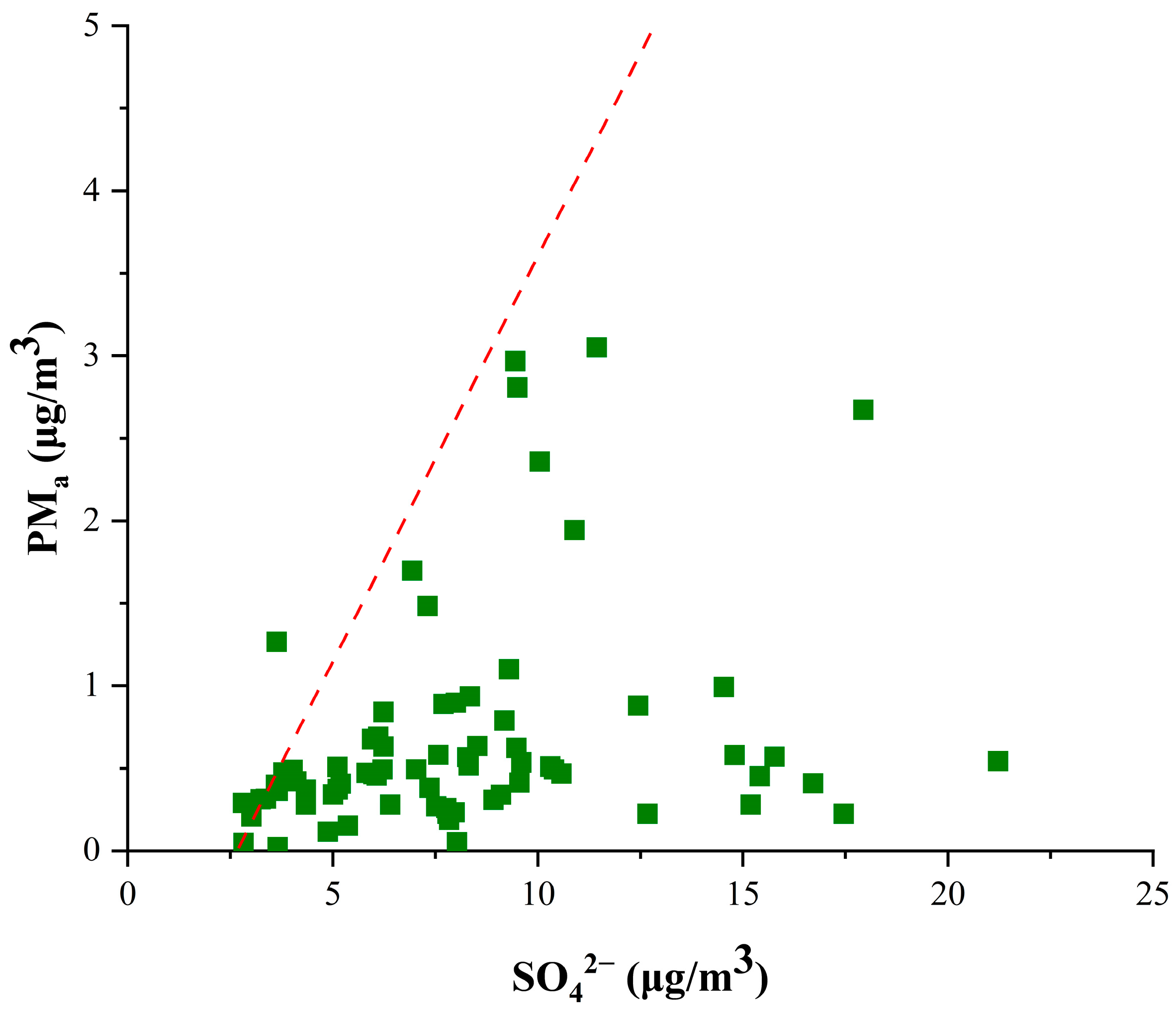
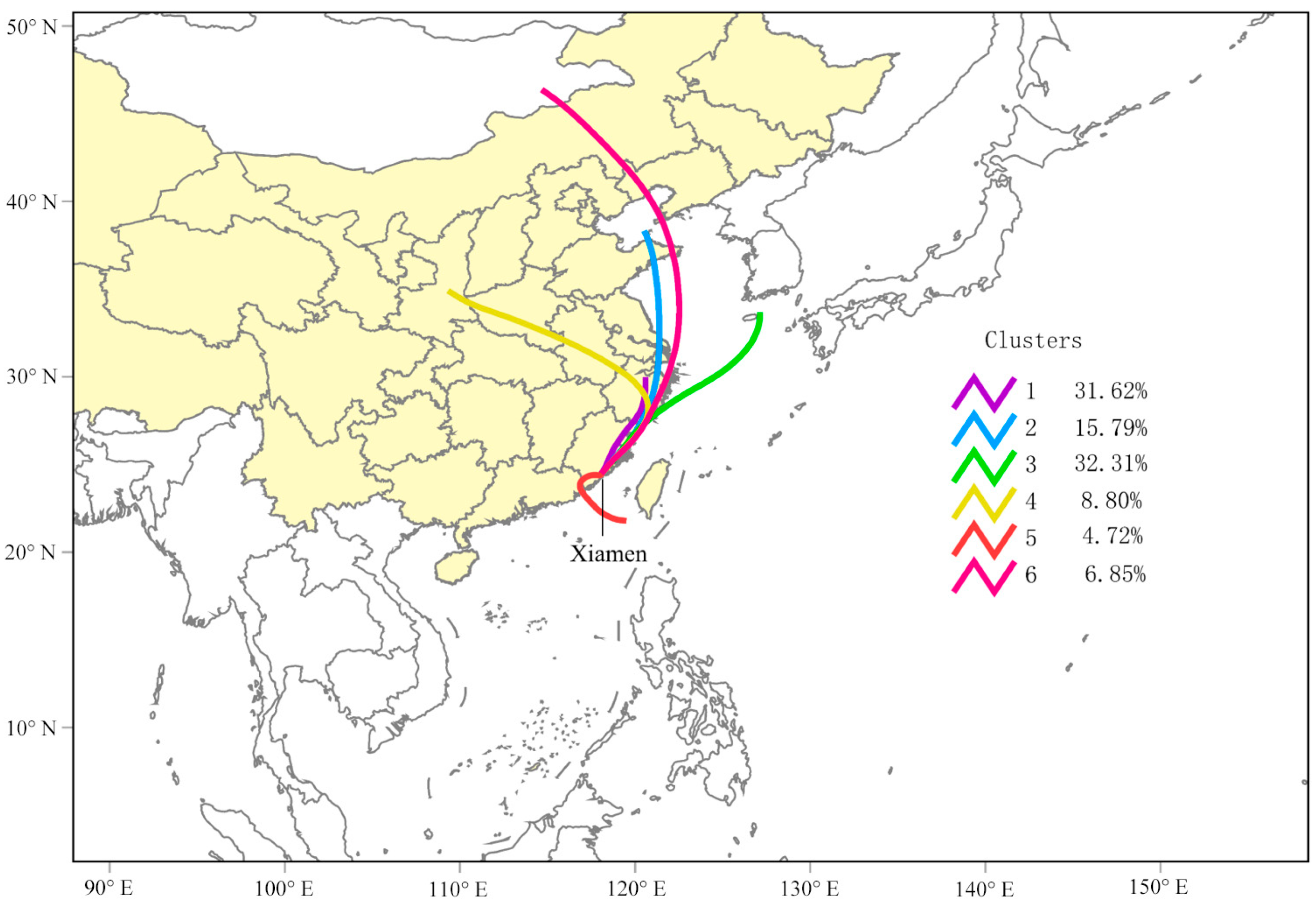

| Year | PM2.5 | GM | OM | EC | TE | NO3− | SO42− | NH4+ | Total | Others |
|---|---|---|---|---|---|---|---|---|---|---|
| 2013 | 39.44 | 3.94 | 8.85 | 1.88 | 5.56 | 4.39 | 10.86 | 2.48 | 37.97 | 1.47 |
| 2015 | 32.50 | 8.39 | 7.64 | 2.24 | 0.81 | 2.02 | 7.38 | 3.77 | 32.24 | 0.26 |
| 2017 | 32.01 | 4.68 | 13.68 | 0.88 | 1.76 | 3.58 | 5.16 | 1.27 | 30.51 | 1.50 |
| Year | Temperature (°C) | Relative Humidity (%) |
|---|---|---|
| 2013 | 23.57 | 62.65 |
| 2015 | 24.31 | 75.59 |
| 2017 | 20.84 | 69.88 |
Disclaimer/Publisher’s Note: The statements, opinions and data contained in all publications are solely those of the individual author(s) and contributor(s) and not of MDPI and/or the editor(s). MDPI and/or the editor(s) disclaim responsibility for any injury to people or property resulting from any ideas, methods, instructions or products referred to in the content. |
© 2025 by the authors. Licensee MDPI, Basel, Switzerland. This article is an open access article distributed under the terms and conditions of the Creative Commons Attribution (CC BY) license (https://creativecommons.org/licenses/by/4.0/).
Share and Cite
Chen, L.; Wang, J.; Wang, Q.; Hong, Y.; Wang, X.; Yang, W.; Han, B.; Zhuang, M.; Bai, Z. Temporal Dynamics and Source Apportionment of PM2.5 in a Coastal City of Southeastern China: Insights from Multiyear Analysis. Atmosphere 2025, 16, 1119. https://doi.org/10.3390/atmos16101119
Chen L, Wang J, Wang Q, Hong Y, Wang X, Yang W, Han B, Zhuang M, Bai Z. Temporal Dynamics and Source Apportionment of PM2.5 in a Coastal City of Southeastern China: Insights from Multiyear Analysis. Atmosphere. 2025; 16(10):1119. https://doi.org/10.3390/atmos16101119
Chicago/Turabian StyleChen, Liliang, Jing Wang, Qiyuan Wang, Youwei Hong, Xinhua Wang, Wen Yang, Bin Han, Mazhan Zhuang, and Zhipeng Bai. 2025. "Temporal Dynamics and Source Apportionment of PM2.5 in a Coastal City of Southeastern China: Insights from Multiyear Analysis" Atmosphere 16, no. 10: 1119. https://doi.org/10.3390/atmos16101119
APA StyleChen, L., Wang, J., Wang, Q., Hong, Y., Wang, X., Yang, W., Han, B., Zhuang, M., & Bai, Z. (2025). Temporal Dynamics and Source Apportionment of PM2.5 in a Coastal City of Southeastern China: Insights from Multiyear Analysis. Atmosphere, 16(10), 1119. https://doi.org/10.3390/atmos16101119








